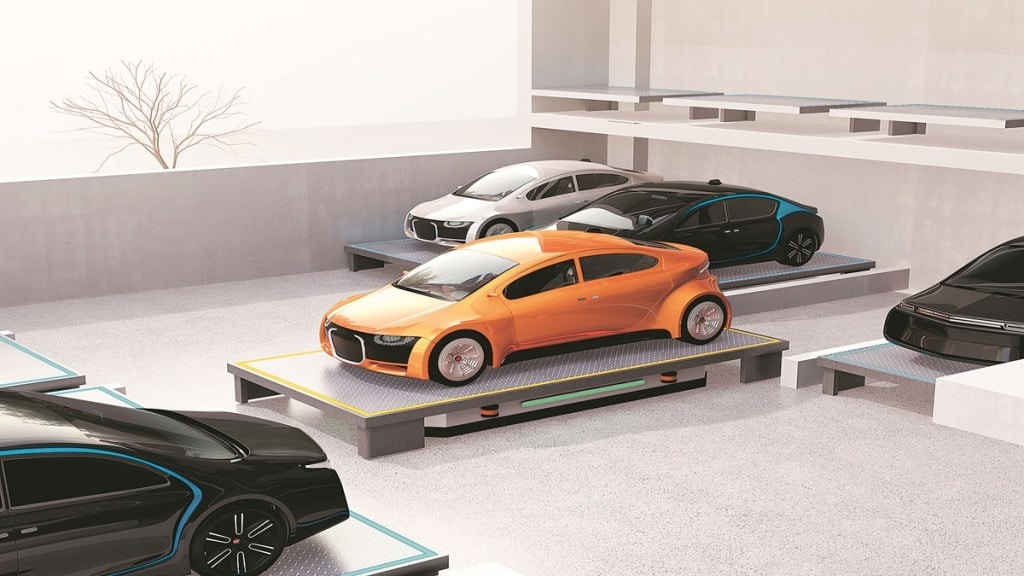As Indian cities buckle under the pressure of soaring vehicle ownership, over 300 million registered vehicles and more, traditional parking methods are proving inefficient and unsustainable. Robotic car parking systems powered by automation, AI, and mechanical engineering are emerging as a vital solution to this pressing urban challenge. It relies on automated systems, and robotic shuttles to park and retrieve vehicles, eliminating the need for manual parking and maneuvering.
India’s push towards robotic parking
This month, Delhi will get its first robotic car parking system in Greater Kailash I. The project, costing Rs 63.7 crore, will accommodate 399 cars with the sole aim to ease traffic congestion in the market area. A multilevel shuttle facility will automate the parking process, eliminating the need for human-driven parking, ramps, and winding pathways. It also offers enhanced security, with restricted human access and surveillance cameras. The project is developed by the Municipal Corporation of Delhi (MCD). That’s not all. Swiss automated parking solutions major Sotefin SA’s Indian subsidiary, Sotefin Bharat, is supporting indigenous manufacturing of robots for automated parking systems in West Bengal. The parking solutions company has planned an Rs 80-crore IPO to support and build a manufacturing facility of parking robots for automated parking in West Bengal.
ARAPL (Affordable Robotic and Automation Limited) in Pune is developing a robotic car parking system using automated guided vehicles (AGVs). This system, developed in collaboration with their subsidiary ARAPL RaaS, is a mobile robotic multi-level car parking solution.
While work has begun on south Mumbai’s first multi-level robotic public underground parking next to Flora Fountain in Hutatma Chowk, news reports state that this automated facility will have a capacity of 194 cars, which will be four times the existing capacity in the area. So what makes robotic parking systems stand out as a space-saving innovation? Conventional parking structures require around 25-35 sqm per car. A robotic system slashes this footprint to just 10-15 sqm per car by stacking vehicles vertically and eliminating ramps and driveways.
Why robotic parking stands out globally
With retrieval times of just 2-3 minutes, automation minimises delays and congestion, vital in time-pressed Indian cities. By avoiding idling and endless searching for spots, these systems cut emissions. Studies even suggest up to a 40% reduction in CO2 in high-density areas. However, modular expansion and design flexibility mean that the robotic systems can scale with rising demand. By integrating EV charging and aligning with autonomous vehicle infrastructure, this can even pave the way for innovation-ready urban ecosystems. It is estimated that the global automatic robotic parking system market size is expected to reach $3.47 billion by 2033. As per research firm Market Growth report, Asia-Pacific leads the market, with China and Japan accounting for more than 41% of all new installations of automatic robotic parking systems as of 2024, while North America follows closely with a growing footprint in major US metropolitan areas.
But the largest robot parking system in the world is located in Al Jahra, Kuwait, with a capacity of 2,314 vehicles. This facility, known as the Al Jahra Court Complex, holds the Guinness World Record for the largest automated parking facility. The system is designed and implemented by Robotic Parking Systems, a US-based company where the design allows for high capacity with a minimal footprint, freeing up valuable surface area for other uses.
The Emirates Financial Towers in Dubai is another example with 1,191 parking slots, while the Dokk1 library in Aarhus, Denmark, has the largest space in Europe, with 1,000 spaces.
However, Europe has more than 500 projects in countries like Germany, the UK, France, and the Netherlands as many involve retrofitting heritage sites, with retrieval times getting faster (under 75 seconds). Globally, fully automated systems dominate due to their efficiency, safety, and long-term savings, while emerging trends include AI, cloud connectivity, IoT integration, and green design, fan the flames of adoption.
But challenges like initial costs and scepticism towards automation can slow adoption. Demonstration projects and public awareness are key to gaining confidence in this segment. Even as continuous operation demands reliable power and skilled technical support, there is also unreliable electricity in certain towns which may need backup solutions like solar panels or battery storage. Success also hinges on collaborations like public-private partnerships, regulatory incentives, and inclusion in smart city plans to accelerate this kind of change.
For example, Mumbai’s ambitious Worli tower saw its robotic parking budget trimmed from Rs 96 crore to Rs 72 crore after public scrutiny, prompting more transparent, budget-conscious approaches to deployment.
On the other hand, ARAPL has installed some automated parking for public projects in smart cities like Visakhapatnam and Kerala, but there is slow adoption either due to high costs or low preference from homeowners.


